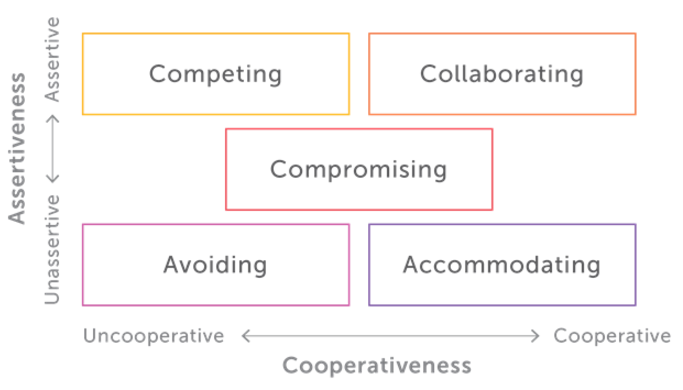Conflict is an inevitable element of human society. This is because individuals/groups have numerous differences in interests to attain a scare resource.
Conflict can be defined as a struggle between segments of society over valued resources.
“Conflict may be defined as a situation of competition in which the parties are aware of the incompatibility of potential future positions, and in which each party wishes to occupy a position that is incompatible with the wishes of others.” –Kenneth E. Boulding
Like in every aspect of human society, conflict in the workplace is unavoidable.
For instance, you might have noticed conflict among employees due to differences in personality, conflict among employees competing for the same goal, and so on.
When not addressed, conflict can have grave consequences in the organization. However, not all conflicts are destructive. Some conflicts bring a transformational path to improve the organization.
Sources of Conflict
Conflict arises due to differences in perspective, values needs, etc. The major sources of conflict are:
- Individual differences
- Socio-cultural differences
- Political differences
- Economic differences
- Psychological differences
- Religious differences
- Racial/caste differences
- Social class differences, etc.
Consequences of Conflict
It is often assumed that conflicts have negative consequences in an organization. However, it is not entirely true. Some conflicts bring constructive changes in the organization. Hence, conflict can be categorized as constructive conflict and destructive conflict.
Constructive Consequences of Conflict
- Better Decision Making: Contrasting views tests a topic from multiple angles. A thorough analysis of the topic builds knowledge about many possible outcomes of each step. Hence, informed decisions are taken.
- Gives Birth to New Ideas: Conflict is a catalyst for innovation. Diversity in ideas brings forth a new style. David Novak, co-founder and former chairman and CEO of Yum! Brands, suggests that disagreement is a necessary part of the process. According to him, “The road to real alignment is often paved with conflict.”
- Organizational Growth: When there is agreeableness among all team members all the time, the organization becomes stagnant. ‘Groupthink’ kills creativity.
Conflict allows learning and widens the chances of organizational improvement. - Improves Productivity: Intensity in the work environment brings a sense of urgency. It fuels employees to be more productive.
Destructive Consequences of Conflict
- Waste of Time and Resources: Presenting each other’s views, debates, and coming to a resolution takes a lot of time and resources. Instead of focusing on the objectives, the conversations can divert into other topics.The business can incur losses if decisions are not taken in time.
- Unhealthy Work Environment: When conflicts are not addressed, they can create an unhealthy working relationship among employees and even groups.
Conflict can give rise to unhealthy competition, groupism, favoritism, etc. The situation can get uglier when conflict takes a personal edge. - Employee Turnover: Turnover is a major negative consequence of conflict gone badly. The company has to lose precious human resources. What’s more, the company incurs the hiring and training costs of a new employee.
- Psychological Distress: Conflict can put an employee through psychological distress. In the long run, the distress can take the form of physical ailment and psychological trauma.
The Thomas-Kilmann Conflict Mode Instrument
The Thomas-Kilmann model of conflict organizes five conflict management styles based on two dimensions: assertiveness and cooperativeness.
Individuals vary in the way they react to conflict. Every style has a different degree of assertiveness and cooperativeness. In other words, how much focus is on your concerns and how much on satisfying other people’s interests.
In any conflict situation people respond in one of the several ways; by competing, accommodating, avoiding, collaborating, or compromising.

- Avoiding: Avoiding style in conflict shows high levels of uncooperative and unassertive response. In this situation, people tend to recognize the conflict, however, they want to withdraw from it or suppress it.
While conflict avoidance may not be a significant problem if the issue is trivial, it becomes a problem when individuals avoid confronting important issues because of a dislike for conflict or a perceived inability to handle the other party’s reactions.
- Competing: Competing is a win-lose approach. In this style, a person tries to satisfy one’s interests regardless of the impact on other parties. There is an assertive attitude to achieve one’s own goal with no tendency to cooperate. This approach may be appropriate for emergencies when time is of the essence of where you need quick decisive actions.
- Collaborating: Collaborating is a win-win approach. Parties in conflict join hands to satisfy the concerns of all parties and search for a mutually beneficial outcome.This can be used for complex scenarios where you need to find a novel solution. This can also mean reframing the challenge to create a bigger space for everybody’s ideas.
The drawback of this approach is that it requires a good level of understanding and trust among the team members. Further, reaching a consensus may consume more time and resources.
- Accommodating: In this approach, you lose and let the other side win. You cooperative to a high degree and it may be at your own expense and work against your own goal. This approach should be promoted when the other party is an expert or has a better solution. It can also be effective in preserving future relationships.
- Compromising: In this approach, both sides win some or lose some. It requires a moderate level of assertiveness and cooperativeness.
It may be appropriate in scenarios where you need a temporary solution.
No organization is free of conflict. Given this fact, conflict is not something that should be entirely dreaded. When channelized well, it carves a way for organizational growth.







